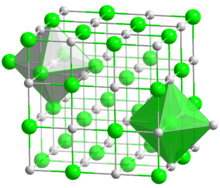
| |
| Names | |
|---|---|
| IUPAC name
Tin telluride
| |
| Other names
Tin(II) telluride, Stannous telluride
| |
| Identifiers | |
3D model (JSmol)
|
|
| ECHA InfoCard | 100.031.728 |
PubChem CID
|
|
CompTox Dashboard (EPA)
|
|
| |
| |
| Properties | |
| SnTe | |
| Molar mass | 246.31 g/mol |
| Appearance | gray cubic crystals |
| Density | 6.445 g/cm3 [2] |
| Melting point | 790 °C (1,450 °F; 1,060 K) |
| Band gap | 0.18 eV [3] |
| Electron mobility | 500 cm2 V−1 s−1 |
| Structure | |
| Halite (cubic), cF8 | |
| Fm3m, No. 225 | |
a = 0.63 nm
| |
| Octahedral (Sn2+) Octahedral (Se2−) | |
| Thermochemistry | |
Heat capacity (C)
|
185 J K−1 kg−1 |
| Related compounds | |
Other anions
|
Tin(II) oxide Tin(II) sulfide Tin selenide |
Other cations
|
Carbon monotelluride Silicon monotelluride Germanium telluride Lead telluride |
Except where otherwise noted, data are given for materials in their standard state (at 25 °C [77 °F], 100 kPa).
| |
Tin telluride is a compound of tin and tellurium (SnTe); is a IV-VI narrow band gap semiconductor and has direct band gap of 0.18 eV. It is often alloyed with lead to make lead tin telluride, which is used as an infrared detector material.
Tin telluride normally forms p-type semiconductor (Extrinsic semiconductor) due to tin vacancies and is a low temperature superconductor.[4]
SnTe exists in three crystal phases. At Low temperatures, where the concentration of hole carriers is less than 1.5x1020 cm−3 , Tin Telluride exists in rhombohedral phase also known as α-SnTe. At room temperature and atmospheric pressure, Tin Telluride exists in NaCl-like cubic crystal phase, known as β-SnTe. While at 18 kbar pressure, β-SnTe transforms to γ-SnTe, orthorhombic phase, space group Pnma.[5] This phase change is characterized by 11 percent increase in density and 360 percent increase in resistance for γ-SnTe.[6]
Tin telluride is a thermoelectric material. Theoretical studies imply that the n-type performance may be particularly good.[7]
- ^ Lide, David R. (1998), Handbook of Chemistry and Physics (87 ed.), Boca Raton, FL: CRC Press, pp. 4–90, ISBN 978-0-8493-0594-8
- ^ Beattie, A. G., J. Appl. Phys., 40, 4818–4821, 1969.
- ^ O. Madelung, U. Rössler, M. Schulz; SpringerMaterials; sm_lbs_978-3-540-31360-1_859 (Springer-Verlag GmbH, Heidelberg, 1998), http://materials.springer.com/lb/docs/sm_lbs_978-3-540-31360-1_859;
- ^ Hein, R.; Meijer, P. (1969). "Critical Magnetic Fields of Superconducting SnTe". Physical Review. 179 (2): 497. Bibcode:1969PhRv..179..497H. doi:10.1103/PhysRev.179.497.
- ^ "Tin telluride (Sn Te) crystal structure, lattice parameters". Non-Tetrahedrally Bonded Elements and Binary Compounds I. Landolt-Börnstein - Group III Condensed Matter. Vol. 41C. 1998. pp. 1–8. doi:10.1007/10681727_862. ISBN 978-3-540-64583-2.
- ^ Kafalas, J. A.; Mariano, A. N., High-Pressure Phase Transition in Tin Telluride. Science 1964, 143 (3609), 952-952
- ^ Singh, D. J. (2010). "THERMOPOWER OF SnTe FROM BOLTZMANN TRANSPORT CALCULATIONS". Functional Materials Letters. 03 (4): 223–226. arXiv:1006.4151. doi:10.1142/S1793604710001299. S2CID 119223416.